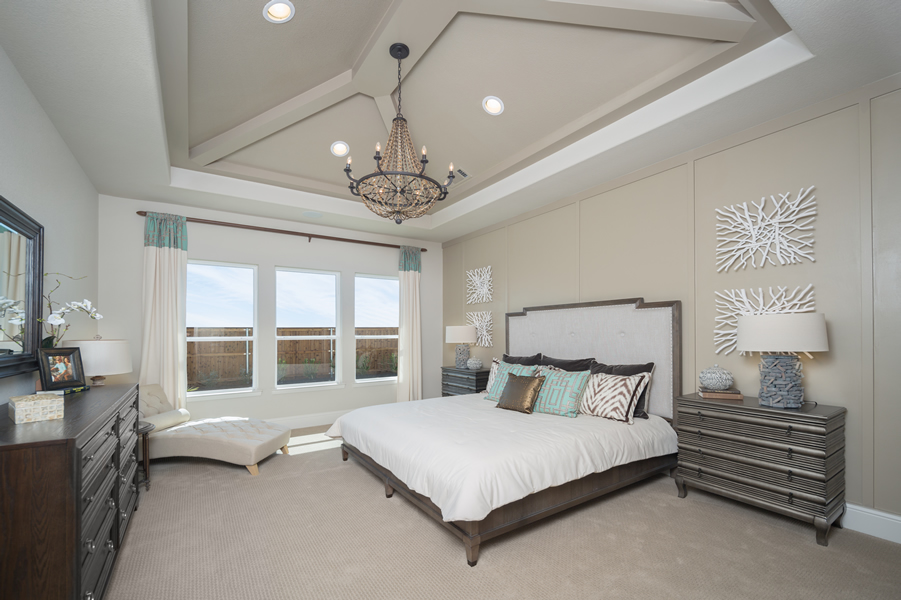
4 Bedroom Painting Tips for a Personal and Functional Space
The bedroom is a unique space to design in any home, and it presents a specific set of challenges. Your bedroom is perhaps the most personal room in your home; a space that should reflect you and that you should feel comfortable in. It’s also a room very few people will ever see, and one that — depending on your weekly schedule — you might not spend a lot of time in. But this is all the more reason to create your own private sanctuary to retreat to at the end of a long day; a journey that begins with picking a paint color! And while it’s tempting to simply choose a bedroom paint color that matches your bedspread or slap on a coat of "Eggshell" and call it a day, picking a color with purpose and intention creates the foundation for your own private, unique retreat in your home. We’re here to offer you some helpful bedroom painting tips to create a space that is beautiful, functional, and all your own.
Psychology of color
We don’t mean to play armchair psychologist, but it’s no secret that color affects our moods. Experts say so! So when considering paint colors for your bedroom, you might take into consideration the psychology of color. Cool colors, for example, create feelings of relaxation and calm; to create a tranquil retreat perfect for resting and recharging, choose a bedroom color in the blue-green family. And while we’d never tell another person what to do with their walls, warm colors — especially red and yellow — tend to stimulate emotion and energy, and some can actually elevate our anxiety levels. It might be smart to save this paint color for a more social, active area, such as a living room.
Accent walls: the best of both worlds
So many people dream of painting a bedroom a bold statement color, but are afraid of overpowering the room or living to regret the decision. This is a completely valid concern. To satisfy both your artistic vision and your sensible caution, consider giving your bedroom an accent wall. An accent wall is a single, well-chosen wall in a room that is painted a different color than the rest of the walls in that same room. This can be a fantastic way to give personality and style to a bedroom without overwhelming the overall design. A couple things to consider: When deciding which wall will be your accent wall, choose the space that the eye is naturally drawn to. Take the example below.

This design uses accent color pieces to highlight the most prominent wall in the room: the wall next to those beautiful floor-to-ceiling windows. This wall would be a perfect accent wall because the windows and the shape of the room draw your eye towards it. For more suggestions on choosing an accent wall in your bedroom check out this blog on The Spruce. Here are more examples of bedrooms.
See the light
Have you ever found that perfect paint color at the store, purchased a sample, and run home only to find it looks completely different — and terrible! — on your wall at home? We’ve all been there! And chances are the issue is with the lighting; so if you want to eliminate that feeling of shock and disappointment when a bedroom paint color betrays you, think about and explore lighting. What direction do your windows face? At what time of day does the color look its best and will you be there to enjoy it? What type of bulbs are you using? For example, that store where you bought the treacherous paint color uses fluorescent bulbs, which enhance cool colors while dimming warm ones — and very few homes feature fluorescent lighting. LEDs work with almost everything, so if all this talk of north-facing windows and mid-afternoon light is making your head spin, you can always invest in some new bulbs and keep the windows closed! For all the details on how room direction, time of day, and more affect the lighting — and paint color — of a room, check out Apartment Therapy’s detailed blog.
Ceiling the deal
Another opportunity to add personality and creativity to painting a bedroom is to consider the ceiling. Most of us find comfort and stability in the familiarity of a white ceiling, and they are fully functional as well: white ceilings make bold colors pop and bring light to rooms with little natural illumination. However, those who live to experiment and defy conventions might find a painted ceiling just their kind of unexpected. Including the ceiling in your project offers all kinds of functional opportunities, as well. You can create a cozy, intimate feeling with a dark paint color, which gives the illusion of a lower ceiling and a close, comfortable space. Or use an eggshell or satin finish, or a tinted paint color for a bolder look. You can even paint the ceiling the same color as the bedroom walls; small spaces will feel cozier and large spaces more unified.
